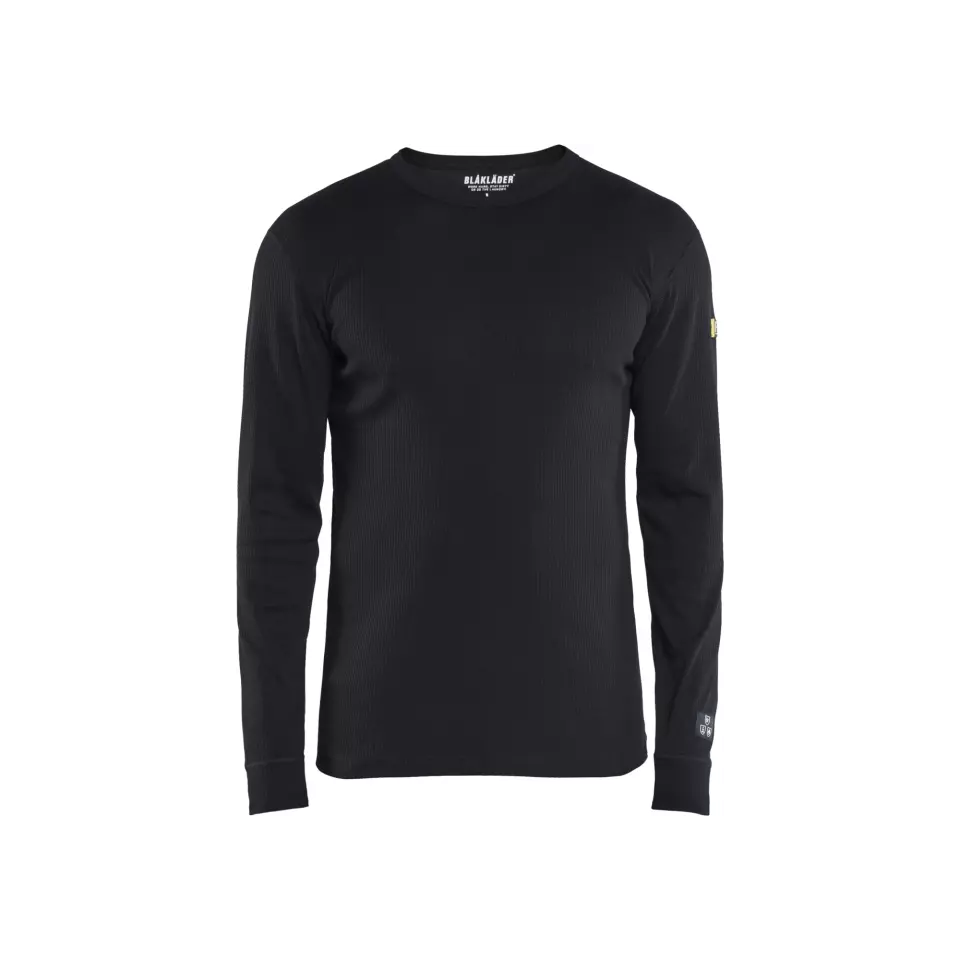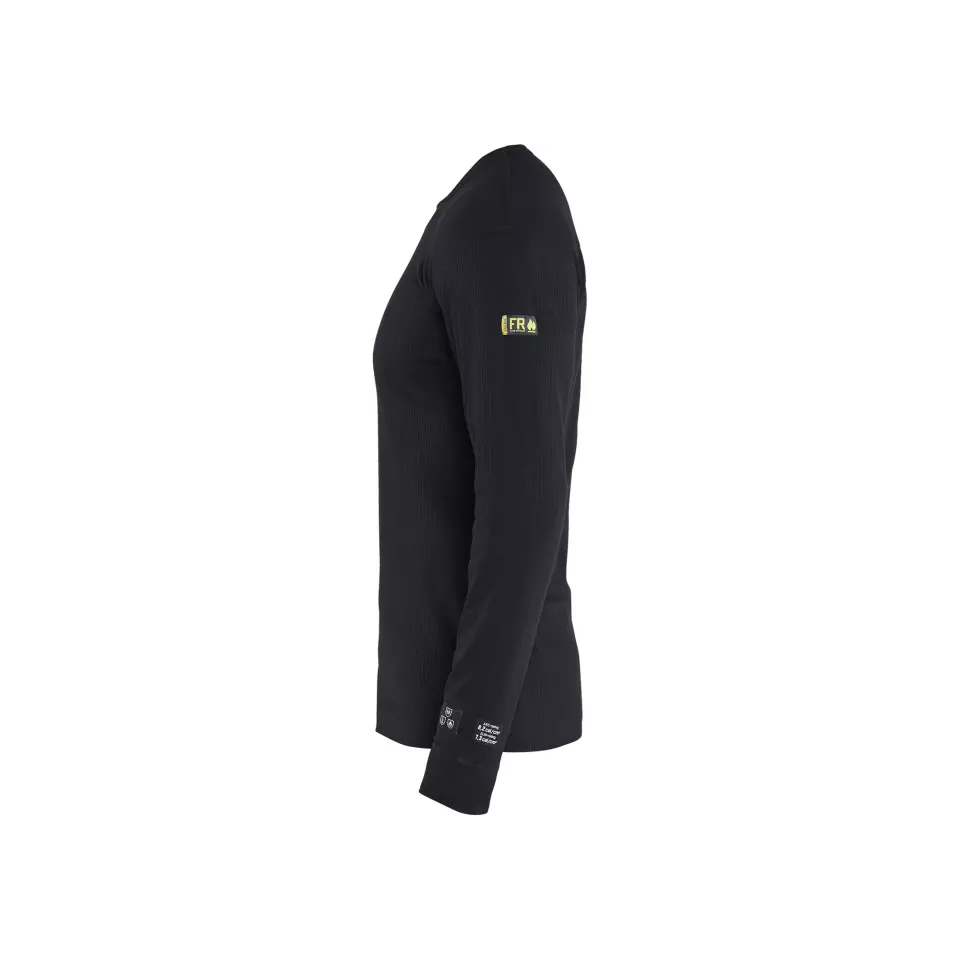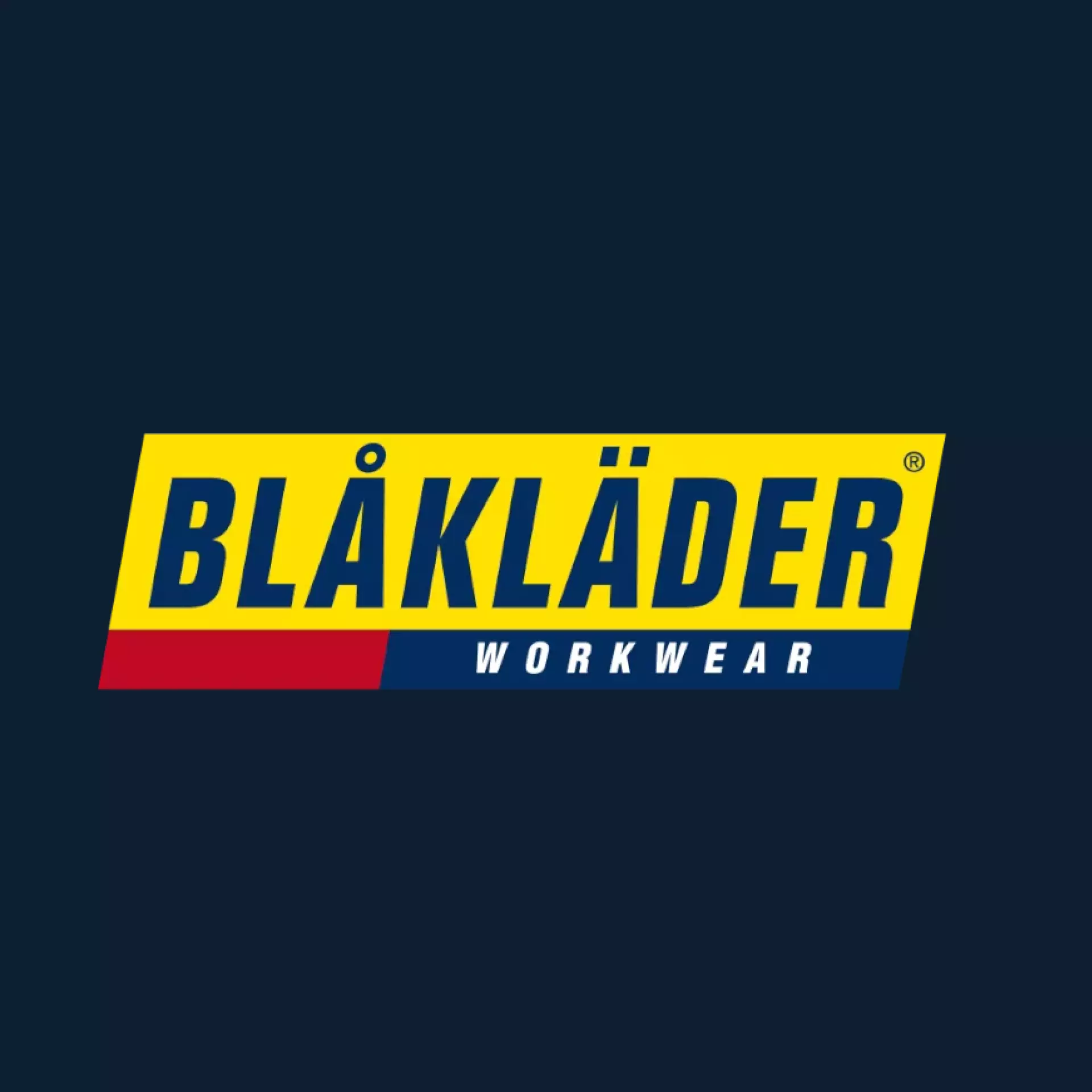Blåkläder Flame Retardant Undershirt, Black
Blåkläder
visit storeProduct description
This flame-retardant undershirt provides lasting protection against heat, flames, and arc flash through its comfortable, certified material. Designed as a base layer, it combines antistatic properties with flame protection and meets multiple international safety standards. The unisex construction with crew neck and cuffed sleeves ensures comfort and fit for various applications.
Product Features:
- Unisex design as base layer
- Crew neck with cuffed sleeves
- Rib-knit construction
- Flame-retardant and antistatic
- External certification labels
Technical Details:
- Material composition: 59% Modacrylic, 39% Cotton, 2% other fibers
- Weight: 250g/m²
- EBT: 8.2 cal/cm²
- ELIM: 7.3 cal/cm²
Standards:
- EN 1149-5
- EN ISO 11612: A1, B1, C1
- EN 61482-2: APC 1
- Oeko-Tex Standard 100: SE 23-302, RISE
The design and shape of the neckline, affecting comfort, neck coverage, and how the shirt layers with safety equipment or other work gear.
Measures fabric density in grams per square meter, affecting durability, protection, and comfort in different work environments.
Determines the shirt's appearance and may affect visibility, professional compliance, and practicality in different work environments.
Determines the length of sleeves, affecting protection from hazards and temperature regulation in different work environments.
Defines the overall design and construction of the work shirt, including sleeve length, collar type, and closure method, affecting comfort and functionality.
Indicates the intended wearer and corresponding fit specifications, affecting sizing, proportions, and cut for optimal comfort and appearance.
- Arc Flash Resistance
- Machine Washable
- Electrical Protection
- Heat & Flame Resistance
Request a free sample
Test first and buy later. Visit any product page to request your free sample.
Standards and labels
EN 61482-2:2020 is a European standard that sets safety requirements for protective clothing against electric arc thermal hazards. This standard specifically deals with the protection of the body and limbs (excluding hands and feet) against electric arc thermal hazards from an electric arc. It defines the performance levels for protective clothing, including the level of protection against electric arc thermal hazards, the arc thermal performance and the classification of clothing. The standard also includes test methods to measure the performance of the clothing, such as measuring the incident energy on the clothing and the flame spread. The test results should show that the clothing meets the minimum requirements for protecting the wearer from electric arc thermal hazards.
EN 61482-1-1:2009 is a European standard that sets safety requirements for protective clothing for electric arc. It defines the performance levels for protective clothing, including the level of protection against electric arc, the arc thermal performance and the classification of clothing. The standard also includes test methods to measure the performance of the clothing, such as measuring the incident energy on the clothing and the flame spread. The test results should show that the clothing meets the minimum requirements for protecting the wearer from electric arc hazards.
EN 11612:2015 is a European standard that specifies the requirements for protective clothing against heat and flame. This standard defines performance requirements for material, design, and testing of clothing that protects the wearer from heat and flames. Testing includes measuring the clothing's resistance to heat and flame, as well as its ability to self-extinguish. Pass/fail results are based on the clothing meeting or not meeting the specified requirements.
EN 1149-5:2008 is a European standard that specifies the requirements for electrostatic dissipative (ESD) gloves. The standard defines performance requirements for material, design, and testing of ESD gloves. The gloves must be able to effectively discharge static electricity and protect the wearer from ESD. Testing includes measuring the surface resistance of the glove material. Pass/fail results are based on the gloves meeting or not meeting the specified requirements.
Test results
Material Performance TestedThe EN 1149-5:2008 standard specifies the performance requirements for material used in protective clothing designed to avoid incendiary discharges. The test result Tested means that the material has undergone relevant evaluation procedures to confirm its static dissipative properties. These tests generally involve measuring the electrical resistance of the material in ohms (Ω) to determine its capability to dissipate electrostatic charges and prevent sparking that could ignite flammable substances. The practical implications of this result for the respective product category (like protective workwear for use in explosive atmospheres) are significant, as it ensures that the clothing provides a level of protection against electrostatic discharges, potentially reducing the risk of fire or explosion in environments with flammable gases, vapors, or dusts.
EN 1149-3:2004 is a European standard that specifies the requirements for electrostatic dissipative (ESD) footwear. The standard defines performance requirements for material, design, and testing of ESD footwear. The footwear must be able to effectively discharge static electricity and protect the wearer from ESD. Testing includes measuring the surface resistance of the footwear material. Pass/fail results are based on the footwear meeting or not meeting the specified requirements.
Test results
Electrostatic Properties TestedThe EN 1149-3:2004 standard specifies the test method for assessing the electrostatic properties of materials, specifically their ability to dissipate an electrostatic charge. The crucial test result for the standard is that a material must have a half decay time of less than 4 seconds or a shielding factor greater than 0.2 to meet the criteria stipulated by EN1149-5. This is determined through a testing process where a specimen is subjected to an induction effect that charges the material. Its ability to dissipate this charge is then measured by recording the decrease in field charge observed by a probe positioned above the test surface. The practical implications of this result for materials, especially in safety and protective clothing, are significant as it ensures that the material can quickly neutralize electrostatic charges, reducing the risk of discharge sparks in environments where flammable or explosive gases may be present.
EN IEC 61482-1-2:2018 is a European standard that specifies the safety requirements and test methods for clothing that is worn to protect the wearer from thermal hazards such as heat and fire. The standard lays out the minimum safety requirements for the design, construction and performance of the clothing, as well as the test methods for measuring its effectiveness in protecting the wearer from thermal hazards. Test results may include information on the clothing's thermal protection performance, flammability and other safety features. This standard is intended for use in industrial environments where the risk of thermal hazards is present, such as in welding, metal cutting and other operations that generate heat or fire. This standard applies to flame-resistant clothing for thermal hazard protection, and it includes the test methods to determine the thermal protection performance of materials and clothing.
Test results
Low-voltage Circuit Arc APC 1The standard EN IEC 61482-1-2:2018 outlines methods for testing the protection level of materials and garments against the thermal hazards of electrical arcs. Specifically, the APC (Arc Protection Class) 1 rating indicates a specific performance category under this standard, which reflects the minimum level of protection offered by the material or clothing against the thermal effects of an electric arc. The test method used involves a directed and constrained arc, commonly known as the 'Box test'. In this method, the sample material or garment is exposed to a defined electric arc within a controlled box setup to simulate realistic arc flash conditions. The parameters like arc current, duration, and the geometry of the setup are defined strictly to ensure reproducibility and comparability of results. The APC rating derived from this test provides essential data for industries, where workers are exposed to electrical hazards, enabling the selection of appropriate safety clothing that meets regulated safety standards to protect against potential thermal risks posed by electrical arcs. This testing not only assures compliance with safety regulations but also significantly contributes to the enhancement of occupational safety in environments with electrical arc hazards.
Oeko-Tex Standard 100 is a product certification program for textiles, which is awarded by the Oeko-Tex Association. This program verifies that the textile products are free from harmful chemicals. To be able to use the Oeko-Tex Standard 100 label, a product must meet certain requirements set by the Oeko-Tex Association which include limits on the levels of harmful substances such as pesticides, heavy metals, and formaldehyde. The textile products are inspected and certified by Oeko-Tex, they can use the Oeko-Tex Standard 100 label on their packaging to show that they are free from harmful chemicals. This certification is for all types of textiles, from raw materials to finished products, and it is globally recognized.
Blåkläder delivery terms
Free delivery when you order more than 150,00 € from Blåkläder
Supplier shipping fee 6,85 €
Brand minimum 0,00 €
65,29 €
Shipping fee is 6,85 € for orders under 150,00 €
Sold in units of one piece
Need larger quantities?
Other products you may like
Recently viewed
Need help?
Get help from our experts
Other products you may like
Similar products you may like
Autonomous sourcing platform
The most efficient way to source and order supplies for your operations
Sourcing
Ordering
List products you’re looking for and we’ll find the best products and prices for you – all for free.
Need help?
Get help from our experts




